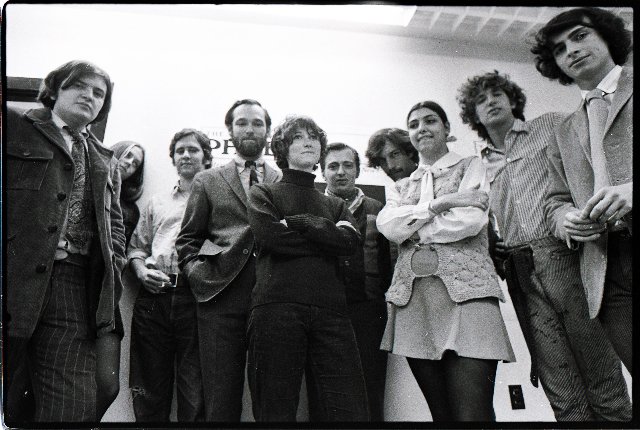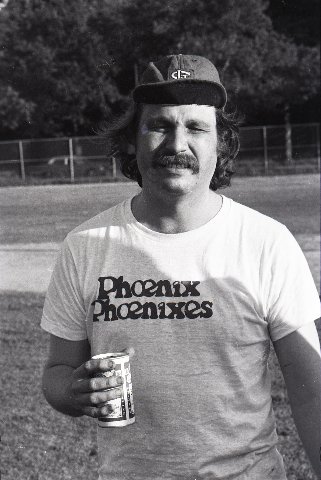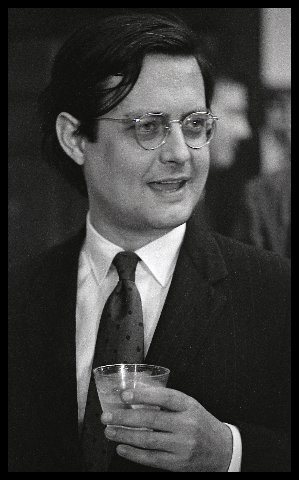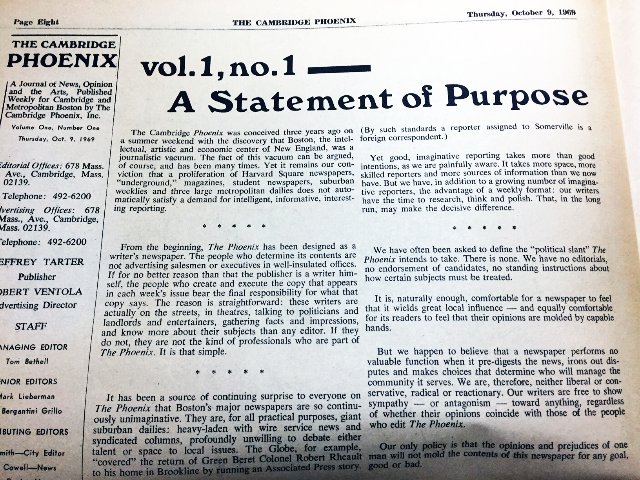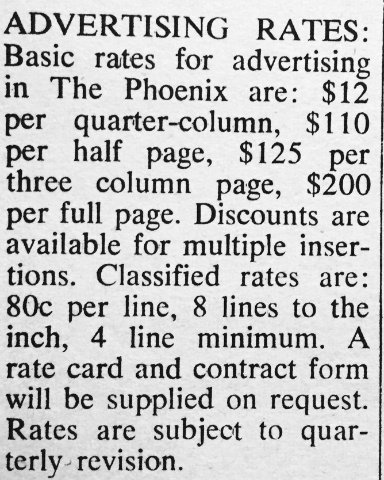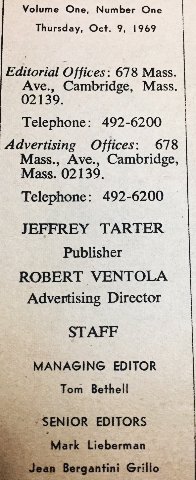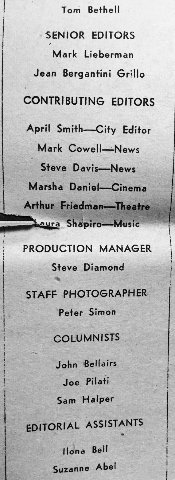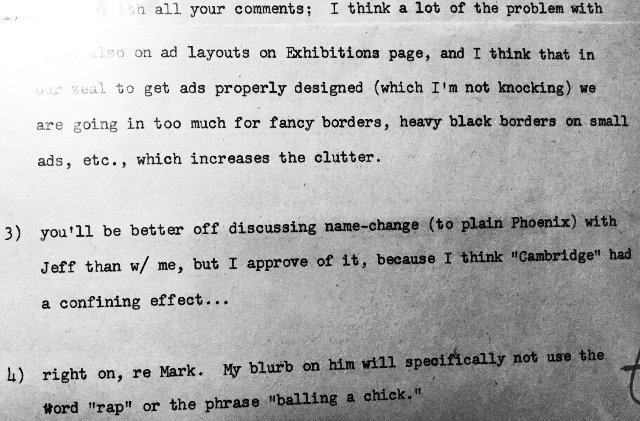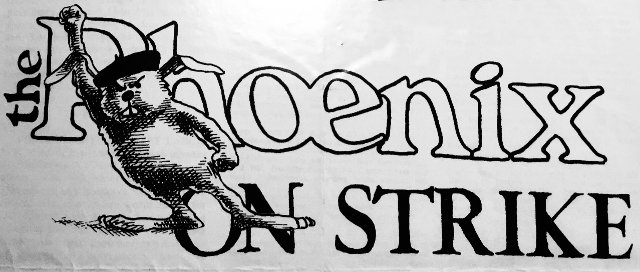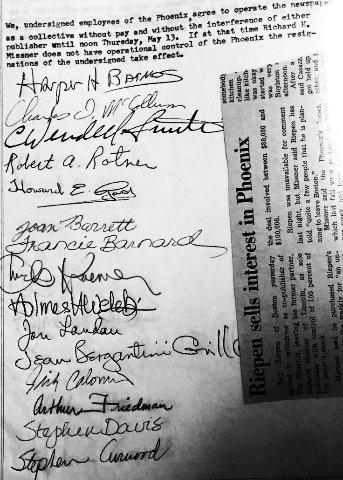Jean Bergantini Grillo on Boston Media
Senior Editor and Art Critic for The Cambridge Phoenix
By: Charles Giuliano - Apr 21, 2019
In 1969 Jean Bergantini Grillo was hired by publisher Jeffrey Tarter who was launching a weekly paper The Cambridge Phoenix.
I asked her to ID people in a staff photograph by Jeff Albertson. She has kept a lot of vintage material including notes from editor Harper Barnes.
She responded "I'm holding the original The Cambridge Phoenix Press Kit in my hands. Cover photo by Peter Simon (man at newsstand selling newspapers). Inside are pages with a list of staff: Jeff Tarter, publisher; Robert Ventola , Advertising Director (he's the dark-haired man in back behind Jeff that I called Al ), Managing Editor Tom Bethell (my personal hero who is not in this photo); Senior Editor Mark Lieberman (not in photo); Senior Editor Jean Bergantini Grillo; City Editor April Smith; Stephen Davis, Contributing Editor; Marsha Clayton Daniel (she with the blonde streak in her dark hair), Contributing Editor for Cinema; Arthur Friedman, contributing editor for Theatre (not in photo); Laura Shapiro (not in photo) Contributing Editor for Music; Production Manager Steve Diamond (who I think is in the picture); Staff Photographer Peter Simon; Columnist Joe Pilati; Columnist John Bellairs (whom I don't remember at all). I have the original Statement of Purpose, the Original Ad Rate card and lots of other stuff. I've been saving all this neat stuff for the right time. I'm working on a play about my Phoenix days, so have been holding on to these "momentoes." But eventually, I'm donating the lot."
From 1969 to 1972 she was competition as another popular and widely read art critic. We caught up recently to discuss that era. She stated that she thought of herself more as an editor and art reporter than art critic.
Charles GiulianoI In the staff photo of the Cambridge Phoenix by Jeff Albertson you said that you were 24 at the time.
Jean Bergantini Grillo I had taught for a year at Waltham High School. A play that I am writing has to do with that year of teaching. Working with kids after school we were reading “Autobiography of Malcolm X” and it got me fired.
It was the beginning of my writing career. I was editor of my college newspaper. We were very radical. I was a part of Young People’s Socialist League. I got into teaching when my husband was getting an MFA at Boston University. We needed an income. Then I got fired and was desperate to get a job.
There was an ad looking for writers. I sent clips from my college paper. That’s how I got hired at The Cambridge Phoenix. I was the only person on that paper that didn’t know somebody at BU, other than my artist husband.
Jeffrey Tarter (publisher a Vietnam veteran who had written for Stars and Stripes) was older than me but most of the staff were younger. I was married. It was called The Cambridge Phoenix because it started in Cambridge. I always said we should drop Cambridge and just call it The Phoenix. It launched in 1969.
I had a lot to do with the establishment of the paper and my fine arts coverage was an aspect of what I was doing. I hired Laura Shapiro and Chuck Kraemer. I worked with Harper Barnes in editing. When I walked in the door they were bringing in the desks.
I have the first letter that went out with our statement of purpose. "This is our rate card and what we charge for advertising." I was there at the birth of the paper.
CG Describe Jeffrey Tarter.
JBG He was a very buttoned down kind of guy. He had been in Vietnam. I remember a section he wanted to call Free Fire Zone which was a term from the war. He had a relative that owned Avery Labels and that was where some of our financing was coming from. He was kind of square but had the sense that the Globe and Herald were not publishing what young people were interested in. Harper was really the one that provided a journalistic point of view. He was the best hire that Jeff made.
I was the senior editor and art was just one of my duties. Harper was the editor and I worked under him.
CG I sense that he came in later.
JBG I have the first issue but not here (Rhode Island) it’s back in New York. I would have to look at the masthead. I think that Jeff was the first editor. We had columnists of which I was one.
(There was no editor. Tom Bethell was listed as managing editor.)
CG When did C. Wendell Smith become a part of the mix?
JBG I would have to check that. I’m in touch with him. He is still doing poetry. He’s a doctor you know. He went to med school after The Phoenix/ Real Paper. I send him my plays and he sends me his poetry.
CG What was the mood and feeling of what you were doing at that time?
JBG In the beginning it was strictly the business of launching a newspaper. It wasn’t a radical paper. Later, when it evolved as The Real Paper. was when it was radicalized. Initially, we were going to be a newspaper with ad rates. There was a business plan and we were going out to advertisers. Everyone on staff had functions.
(The Real Paper was organized by the former Cambridge Phoenix staff when the paper was sold to Stephen Mindich. It ran from August 2, 1972 through 1981.)
Somebody had all the movie theatres but didn’t want someone to advertise for some reason or other. I thought you have to have advertising. If we pick and choose who advertises we’re not going to last long. There was a constant discussion of how radicalized we were going to be. We had to think about, were we just going to be a mouthpiece, or were we going to be a paper?
There was always that push and pull. Abbie Hoffman and some underground people came to speak to us. They were talking about getting explosives and blowing up buildings. I remember thinking that’s kind of dangerous. People can get hurt. I’m not so sure. Some of these people are not that heroic.
I was just trying to make enough money to live. I came from a different background than some of these kids. I went to a state college.
(University of Rhode Island. She was one of six daughters. Her father ran a bakery and the girls all had jobs.)
After a year The Phoenix ran out of money and we were going to try to be a cooperative. I started to bring in food for the staff. One of the staff members (photographer Peter Simon) who said “I’m not going to work unless I get paid” came in with a brand new car. I was broke and he had family money.
CG Talking with Arnie Reisman and Harper Barnes there are different takes on Tarter. The perception was that he wanted to create a version of The Village Voice.
JBG He had a business model. He didn’t want to be an underground paper. He wanted to be an above ground paper. Those of us who signed on wanted to be above ground but we were a part of the counterculture.
CG He was founding a paper that would compete with Boston After Dark for the extensive (250,000) college/ youth market. At that time, BAD was entirely focused on entertainment. Because of the diversity of The Cambridge Phoenix the Stephen Mindich paper came around to that at a later time to keep up and compete.
JBG Everyone wanted to cover music. My husband Stephen was an artist and that was radical. Parents want their kids to be doctors and lawyers but nobody tells them to go paint. For us, coming from parents who lived through the Depression, art was a radical thing to do. A lot of the artists I interviewed had a very radical sensibility. I didn’t have an art background. I was an English major. I thought of myself as an art reporter. When I interviewed Walker Evans I asked if he kept in touch with the people he photographed? What did he think of them as symbols of destitution? It impressed me that he had feelings for them and wasn’t just shooting and running.
CG He and James Agee published “Let Us Now Praise Famous Men.” Belinda Rathbone, daughter of Perry Rathbone, wrote an Evans biography. She discussed how Evans returned and stayed in touch with those families. On holidays he brought them presents.
JBG She probably got that from my interview. Evans talked about that. She may have read my article in The Phoenix. As an English major Walker Evans wasn’t someone I knew about. Literally, I was reading the book before doing the interview. I was as young reporter.
CG You said that everyone wanted to write about rock so how did it come about that you covered art?
JBG I said one of the more revolutionary things you can do is paint. They poo pooed that. Nobody wanted to take my art pictures. (Staff photographers were Simon and Jeff Albertson.) Lois Greenfield, who went on to a great career as a photographer said “I’ll go.” None of the guys wanted to take my pictures. They all wanted to do the rock and roll stuff. Lois, who went to Brandeis, went on to a great career. She became the dance photographer for the Village Voice.
CG Did you hire Laura Shapiro as a dance writer?
JBG I saw her stuff in the BU paper and said that we had to hire her and Chuck Kraemer. There were people I saw in the BU paper.
CG Jeff Albertson was also from BU.
JGB He was already on staff. I hired Laura and Chuck. (Kraemer was later an on air arts reporter for WCVB and WGBH.)
CG Steve Davis (rock critic) was also from BU.
JBG He was buddies with Peter Simon.
CG So they were all from BU. Talking with Arnie Reisman, my editor at the Brandeis Justice, he worked with a lot of Brandeis graduates. It seems that the alternative media was either BU or Brandeis.
JBG I was from Rhode Island College. I was doing listings which was critical. People were buying the paper to find out about things. I have all kinds of notes with Harper about how we should do the listings. Years later I met people who said 'you don’t know how important it was to us to be listed in The Phoenix.'
We started with 320 subscriptions. Later, we had a circulation of 50,000. We went from paid subscriptions to free. Hawkers were something that changed us overnight. That changed distribution. I have a letter from a Brandeis student. It said “We don’t want Boston After Dark on our campus. We want The Phoenix.” Boston After Dark had distribution that we didn’t have. That’s when we went with hawkers and it put us on the map.
CG What kind of money were you making?
JBG It only lasted for a year then they ran out of money. I was making $8,000 as a teacher. When I was fired we were totally broke. Then $8000 was the entry salary that Tartar was paying for a senior editor. When the paper ran out of money we agreed to work as a commune. We’ll try to get advertising and make what we make. It was Peter Simon who said “I have to get paid.” He announced that he would not take photographs unless he got paid then drove in with a brand new car.
CG At that point Ray Riepen and a partner (Richard Missner) bought out Tartar.
JBG We started to get salaries again.
CG Did you know Riepen?
JBG No, no, no. That was the end of Jeff.
CG Day to day the paper was being run by Harper?
JBG Yes. Harper was my editor then Paul Solman was my editor (as The Real Paper).
CG Harper was a trained journalist who had worked at the St. Louis Post Dispatch. As he describes it he was running a hippie paper and wanted to keep that while applying journalistic standards.
JBG I have wonderful correspondence with Harper in which we discussed that. He wrote to me “Yes Jean, I agree, we should stop using far fucking out.”
CG As I understand it when Riepen and Missner took over they wanted to make the paper more commercial. Part of that was firing Harper. The staff rallied and walked out. There was a scab Phoenix but eventually the staff returned with a union. Part of that was negotiating severance pay for Harper. He lived on it for several months. Then Riepen and Missner sold the Phoenix to Mindich. There was a pattern of Steve buying competitors and either merging or folding them. That’s when the staff formed The Real Paper as a cooperative and elected Solman as editor.
JBG I was with The Real Paper for a short time. I had been offered a job at the Boston Globe as an art critic. At that time Stephen (Grillo) was showing at an art gallery in New York so our future was to go there. I always saw myself as an editor much more than having a column. I edited everybody’s stuff.
When everyone went to Woodstock I couldn’t go. I was editing the stuff that came back. Somebody had to be there. People were coming in saying “I’ll never wash the dirt off my body.” I said “Hand me your copy please.”
I saw a lot of people were just destroying themselves with drugs. There were brilliant minds that just fried their brains. Some of us had to work and edit that copy. On top of that I interviewed Walker Evans, Andy Warhol, and Linda Benglis. I was talking to people with brilliant artistic minds.
There was no support for what I was doing. There was disdain because they were just interested in rock and roll. But I loved rock and roll. We were at the Tea Party, dancing and doing all that stuff.
My favorite exhibition was something that Marty Mull did (with Todd McKie) called “Flush with the Walls” in the basement men’s room of the MFA. We covered it. Nobody else did. The MFA at that time did not have a department of contemporary art. That was shocking.
CG Ken Moffett was the first curator when a department was formed in 1971.
JBG I’m so sorry he is gone. Ken was a great champion of my husband’s art. He came to our house and looked at the work. He was a curator willing to get off his butt and look at artists. A lot of curators don’t do that.
I interviewed anybody who was doing anything. I did a range of things. I interviewed Boris Mirski who was showing the Boston Expressionists. I saw myself as a reporter. I asked people what was behind what they were showing.
I called a black artist who was having a show. He kept saying “Yah gottah know Trane.” I didn’t know what he meant and I asked my husband who said he means Coltrane. I was educating myself as a reporter to understand what was behind what people were doing. I didn’t go in as a critic. I went in as a reporter. I explained the work as a reporter so that the audience who went to see the work would have a better understanding.
CG It was a time of transition and change. The artists were activists. They organized the Studio Coalition which was the nation’s first open studios event. There were talks that I launched at Parker 470 Gallery. The gallery was mobbed when Tony Thompson moderated a discussion with Perry Rathbone. It was polite until Joan Trachtman, wife of the protest artist Arnold Trachtman, bluntly asked him when the museum was going to appoint a contemporary curator. Not long after Rathbone called me at The Herald to tell me that he had hired Moffett. Out of those meetings came the Boston Visual Artists Meeting.
JBG My husband was a part of those meetings and was the first director of the BVAU.
It was a time when America was terrified by young people. Newsweek came and interviewed us. They said “Tell us what’s really going on in the world?” Like we had answers. There was a youth quake and I was extremely skeptical. Imagine, adults coming in and asking us for answers. Weren’t they supposed to be telling us what was going on?
I saw a lot of drugged up people thinking that they had the answers and I said “sorry.” I just saw a lot of fucked up people. I felt we needed to educate ourselves by listening to each other. The government was fucked up, and thing’s weren’t right, but I wasn’t ready to go bomb things. I didn’t see that as a solution.
CG When did you move to New York?
JBG In 1972.
CG I understand that you became involved in elected politics.
JBG There is a position in NY for a male and female district leader. It’s an elected office. You represent your geographic voting area. I was the Democratic leader for the 66th Assembly District. I held that position for ten years. You report to the county Democratic party. They have a meeting once a month and you fill them in on what’s happening. You report on what’s happening in your area.
As I got into my playwriting it was more and more interfering. I retired from that in 2015. 9/11 was the catalyst for playwriting. We live just four blocks away and I saw them come down. I have a niece who got out of one of the towers. After that, I was a food server at St. Paul’s. We were feeding the recovery workers. It was a defining moment in my life. I was freelancing at the time. There was a magazine I created. For nine years Cable Avail covered the cable television industry. An advertisement segment is called an availability. With a partner we launched the magazine in 1991. With the dot.com collapse we had to shut it down. 9/11 really finished off all that. People wouldn’t travel. I worked at St. Paul’s for eight months.
Working there I saw so many people change their lives. Actors became ministers and ministers became actors. I had always been writing non fiction and I decided to do something with creative writing. I sent some stuff to people I had met in the TV industry. Someone I respected said “These are not scripts Jean. These are plays. Your dialogue is spot on.”
I sent work to HP Studios and won a scholarship to their playwrights' workshop in 2005 and have been with them ever since.
CG I understand that you are writing a play about The Phoenix.
JBG It’s a two part play and it begins with the seminal moment when I go fired. That catapulted me because I had always wanted to be a writer. I was told to teach. That was the avenue to the middle class. Four of my sisters teach. So that is what I did. I was always meant to be a writer and did criticism when I was in college.
Part two is about The Phoenix. It had difficulties about women. Laura, Lois and myself had to keep our elbows up. It was a male dominated place. It was not easy. Harper, I must say, really made it survivable. He came in and said “It’s ok. It’s revolutionary to write a grammatical sentence. It’s all right to be coherent.” They put one of my art reviews (Gongora/Merkin) on the front page. I have a note from Tom Bethell about how much he loved the piece.
Somebody came back from Florida with lurid photos of old people on the beach. There were details of wrinkles and sagging flesh. They thought it was funny and wanted to do a spread. I said “These are our grandparents and it’s going to be us someday. It’s not funny.”
There was always a push pull about what are we here for? Did you know that I’m in the Nixon Tapes?
Tricia Nixon came to the MFA to give them a couple of Ming Dynasty vases.
CG I was there.
JBG It was the same day that the photo of a young girl running with her clothes burned off by napalm. I was so incensed that I handed Tricia Nixon a note. I wrote “Nixon gets toasted while women and children get roasted.” Not subtle but I was furious. How could the MFA allows this to happen? I broke every rule of journalism to use that opportunity to hand her the letter. There was no other avenue to express my outrage.
She handed the letter to a Secret Service agent and I thought it’s the end of that. Little did I know that Tricky Dick read the letter and he was outraged. It was captured on tape in the Oval Office. People Magazine called me for comment. I had no idea. That’s my claim to fame.
I have always been a radical at heart though I didn’t look it. People said “Oh, she just covers art.” But I had a very radical soul. I put it in my writing and work.
CG Did you know George Kimball?
JBG Oh George, OMG. It’s like Westerns when they always have a character outside the saloon and everybody tolerates him. He wrote well on sports but he was a major alcoholic. He came in many times and just fell down passed out drunk. I don’t care what you do in your off hours but function and get the copy in. I would come into the office and he would be just blotto. And he had been there from the night before. I can’t write his copy for him. That was the whole macho vibe at that office. I had to hold a lot of that together and edit the copy. Which I did but sometimes it was, hello, I can’t read this.
For some of them it was a lark and they were rich hippies. For me it was a job and I needed the money. I took Tartar to court for back pay and won. My buddies were Laura and Lois. Paul Solman and I were close.
CG You describe yourself as holding down the office, reporting and married. To what extent did you participate in the counterculture?
JBG Totally, My husband and I marched in Washington. We were gassed. I wanted to shake up the art world. When we covered “Flush with the Walls” we criticized the MFA for not including contemporary art. We interviewed Moffett and asked why that hadn’t happened sooner. We criticized the MFA for having stolen artwork. I went to RISD and interviewed Warhol. I was trying to show that art could be revolutionary. I wanted art to be covered.
My husband had his first show in NY in 1968. We were constantly moving back and forth. We were much more aligned with what was happening in NY. He was in the Prince Street Gallery and Green Street Gallery. We were on West Broadway painting a gallery space. I said to my husband “Nobody is going to come down here.” The Bowery Gallery started on the Bowery. It was artists taking control of their art. We are going to show our own work because the dealers don’t know what’s going on. Dealers were taking so much money there was a movement to start a union.
In New York I worked for the Village Voice. OMG. Compared to The Voice The Phoenix was heaven. I saw more shit there. I hightailed it out of there and went to work for the Soho News. My best experience was with The Daily News. I was with them for about four years doing TV criticism. I had such a good time. It was so much fun. But The Voice, OMG, it was absolute chaos. But that’s another story.

